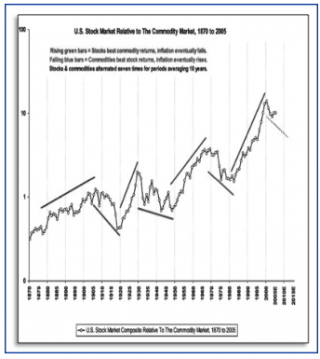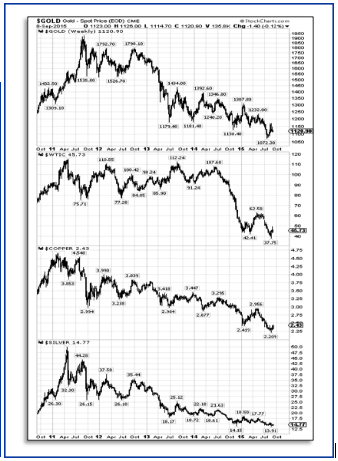Understanding The Secular Commodity And Stock Cycles And What They Mean To Investors
 For many investors, commodity stocks are a bargain. They have declined 40% to 60% from their highs in 2014, their valuations are very favourable and the world still needs natural resources to grow. All of this points to higher price levels in the months to come and a promising opportunity for the long-term investor.
For many investors, commodity stocks are a bargain. They have declined 40% to 60% from their highs in 2014, their valuations are very favourable and the world still needs natural resources to grow. All of this points to higher price levels in the months to come and a promising opportunity for the long-term investor.
However, for students of history, this unwavering belief that commodity prices must come back “has all happened before”.
For example, when the last commodity cycle ended in 1980, many natural-resource investors felt the next boom was just around the corner. Yet it took 20 years before the next secular commodity cycle would start again.
Back in 2005, we were approached by a hedge fund out of Boston to find  out if commodities and stocks had a prolonged period of strength or cycle or was their (commodities) performance to S&P 500 equities largely random (Chart 1).
out if commodities and stocks had a prolonged period of strength or cycle or was their (commodities) performance to S&P 500 equities largely random (Chart 1).
To get a clear picture, we reviewed data going back to 1870 (135 years) and looked for periods of relative performance. What we found was a revolving period of performance that favoured one asset over another. And this period of performance, on average, lasted about 18 years.
As the commodity cycle began in 2000, and the analysis was done in 2005, the outlook suggested that commodities would continue to outperform over stocks (S&P 500) for about another decade—or to 2015. In reality, the (CRB) continued to outperform stocks (S&P 500) until late 2012 and oil kept outperforming until 2014.
Since the switch away from commodities and back to the S&P 500 in 2012-2014, gold prices have dropped 43%, light crude oil has declined by 58%,  copper prices have fallen 52% and silver prices have plummeted over 71% (Chart 2). And at the same time, the S&P 500 gained nearly 200% from the low in 2009 or 38% from the breakout in late 2012.
copper prices have fallen 52% and silver prices have plummeted over 71% (Chart 2). And at the same time, the S&P 500 gained nearly 200% from the low in 2009 or 38% from the breakout in late 2012.
One of the major characteristics of this change favouring commodities or the S&P 500 is the U.S. dollar.
For example, by the end of the last secular stock cycle (1980-2000), the U.S. dollar index (DXY) had risen to $1.21. During the next commodity cycle (2000-2012), the dollar dropped from $1.21 to $0.71. This decline helped bolster natural resources by making them more attractive and more cost-effective.
The contrary is also true.
As the U.S. dollar began to stabilize in 2008 through 2013, and eventually rise in 2014, commodities became less attractive and started to decline.
Bottom line: the shift in relative strength between commodities (CRB) and stocks (S&P 500) is a pattern that has persisted well over a hundred years. And, on average, the strength of one asset group over the other lasts about 18 years.
With the S&P 500 breaking out of a broad 70-month consolidation in early 2013, it is estimated that commodities will continue to underperform the S&P 500 into the next decade. And as the Fed reviews its options for an interest rate increase, this move will only add to the upside strength of the U.S. dollar and the downward drift for commodity prices.
Long-term investors may want to refer to the last stock cycle (1980-2000) to give themselves a reference point of possible stock market movement in the coming years. During that time, most commodity prices remained depressed (gold dropped to $253, copper plunged to $0.60 and oil prices remained under $40), all while the S&P 500 rose from 125 to 1553.
Donald W. Dony, FCSI, MFTA is an analyst, past instructor for the Canadian Securities Institute (CSI) and the editor at the Technical Speculator.com
Email: dwdony@shaw.ca, Ph. 250-479-9463

